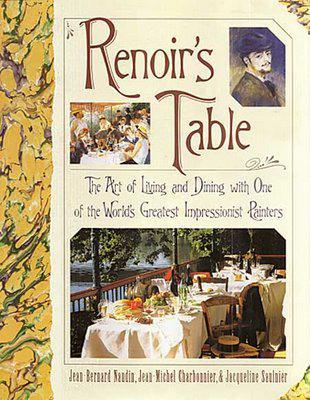

Yesterday Renoir’s Table arrived on my porch. It’s a truly beautiful book. Although it contains sixty recipes, I bought it for its inspiring photographs. Amid a well-written biography of Pierre-Auguste Renoir’s life the books collaborators Jean Bernard Naudin, Jean-Michel Charbonnier and Jacqueline Saulnier, have painstakingly recreated some of the settings of Renoir’s most famous paintings. The only things missing are the people. The setting for the Luncheon of the Boating Party is there with all its details, but it’s as if the painting’s subjects have gone down to the dock to meet the canotiers.
Renoir’s Table flawlessly melds gastronomic details with a biographical sketch of Renoir’s life. The recipes created by Jacqueline Saulnier are well-researched dishes that Renoir might have enjoyed at the time. Because recipes found in this and Saulnier’s other books contain ingredients like goose fat, blanched calves-trotters, and boar’s heads; and amounts like 14 ounces of this and 1lb. 10 ounces of that, I end up never actually following the recipes, but instead being inspired by them. Though I have to say that the Empress Rice Pudding with candied fruit looks fairly tempting and easy…
I have the honour to possess other books compiled by various combinations of these talented collaborators. Toulouse-Lautrec’s Table and Monet’s Table are equally beautiful books and because Toulouse-Lautrec really liked to cook and the recipes found in Monet’s Table are from his personal cook’s recipe book, the recipes ring a little more true.
A work of historical fiction, The Luncheon of the Boating Party, by Susan Vreeland, published by Penguin was a Christmas present. Susan Vreeland's novel centres on famous French Impressionists and their work but specifically, Renoir’s the Luncheon of the Boating Party painted in 1881. I’m not very far into the book, but the research Vreeland has done retracing Renoir's steps while creating this painting and the research into the details of French café society sound like she probably had a lot of fun. This kind of avocation is right up my alley and I envy Vreeland. Despite her dedication I find the narrative sophomoric and strained.
A few years ago I read Renoir, My Father written by Jean Renoir, his movie-producing son. I devoured that book and at that time found out a lot about the Luncheon of the Boating Party, known in French as the Le Déjeuner des Canotiers. One fact being that the seated man in the singlet is famous Impressionist promoter and painter Gustave Caillebotte.
Inquisitive by nature, while at the Toronto Reference Library, I happened upon a Paris City Directory for 1912. I found Renoir’s address on Boulevard de Rochechouart and phone number. How cool is that! I also found Colette and Picasso, but that is for another time.
While The Luncheon of the Boating Party is a very famous painting and I seem to have known it all my life, it was the Glass Man in Jean-Pierre Jeunet’s Amelie that whimsically brought it into my circle of consciousness again. The Glass Man meticulously recreates the picture every year, but cannot seem to capture the essence of the one drinking girl until Amelie comes into his life.
The Luncheon of the Boating Party captures the essence of what my own private Paris is.

